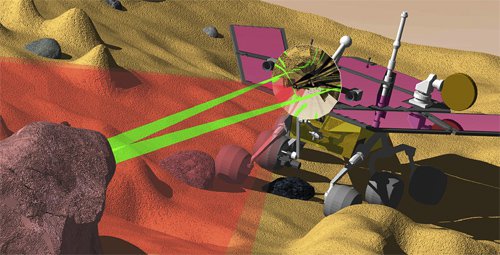
Artists concept of the SLIM instrument on an MER-like Mars rover, examining a rock from a distance.
The Structured Light Imaging Module (SLIM) is a novel instrument that provides high resolution and wide-field imaging and remote microscopy to understand the geological context of a site. It provides ranging capabilities for hazard avoidance, instrument positioning, and scientific planning. The core technology is based on structured illumination that is dynamically synthesized using an Acousto-Optic (AO) device known as a Bragg cell. A Bragg cell consists of a piezoelectric transducer bonded to a transparent crystal. By applying an electrical radio frequency (RF) signal to the transducer, it generates a propagating acoustic wave within the crystal and produces a spatially periodic index grating. By driving the crystal with a superposition of RF frequencies it is possible to diffract multiple 1st-order beams whose amplitude, phase, and angle can be rapidly and precisely controlled via the corresponding digitally-synthesized RF component. Each diffracted beam is Doppler-shifted by the frequency of the corresponding RF tone, resulting in a rapidly moving programmable interference pattern when two such beams are made to overlap using a lens. Strobing the illumination at the difference frequency (e.g., 100MHz) can be used to “freeze” the interference pattern at a programmable phase for slow detectors such as a human eye or a CCD.
This core technology can be used for both 3D ranging and remote microscopy. JPL is working with the University of Colorado at Boulder and with Chiaro Technologies who are developing the instrument, to integrate the sensor onto JPL research rovers and demonstrate mapping and obstacle detection using this technology. While SLIM embodies a new approach to imaging with capabilities difficult to attain with traditional methods, it can also augment more typical imaging systems on near and far-term planetary missions.


